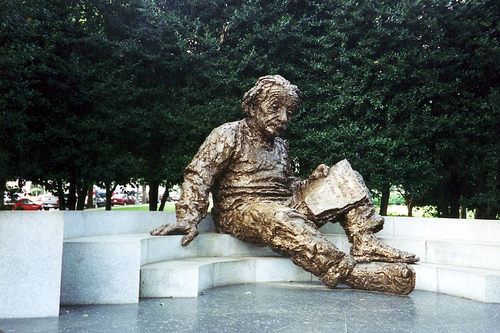 Impact
Impact Roundtable Puts Social and Behavioral Research Back on Agenda

A statue of Albert Einstein sits, literally, outside the front entrance of the National Academy of Sciences.
This week in Washington D.C., the National Research Council will debut a roundtable on the application of social and behavioral science research, hosting two days of talk, the first few hours behind closed doors and the rest open to the public. (While the event is free, because of space limitations, please register.)
“It’s clear that people who control funding for the social and behavioral sciences may not fully appreciate how much the social and behavioral sciences contribute to our daily lives, basic research that has contributed to applications that people now take for granted,” explained Natalie Nielsen, is a senior program officer with the Board on Science Education at the National Research Council and the director of the roundtable.
“There are a lot of conversations in Washington and beyond right now, a lot of organizations working very hard to promote the social and behavioral sciences,” explained. “[The council] can’t lobby for them, but we can contribute to these broader conversations by bringing evidence to bear and then help communicate the relevance of the evidence to policymakers in their daily lives and professional concerns.”
As the NRC noted in announcing the roundtable last summer, these discussions are “premised on the idea that there is a need for better public understanding of the usefulness of [social and behavioral science, or SBS] research and a commensurate need for researchers to improve their understanding of how, when, and what types of SBS research are used by industry, and the education, military, and public health communities.”
Nielsen intentionally echoed psychologist Robert Cialdini in detailing how the system unlocks value: “There’s all these great findings warehoused somewhere, but we don’t have a good distribution or shipping mechanism. One of the things we’re looking forward to doing on this roundtable is connecting that research evidence to the people who use it by hearing what the needs are of these people who use it.”
The council itself, the operating arm of the National Academy of Sciences and the National Academy of Engineering. is a private and nonprofit institution. But as a congressionally chartered organization that offers advice to the national government, it complies with a number of mandates about lobbying and advocacy that also apply to government agencies.
“We are an independent, evidence-based voice,” said Nielsen, “and so we avoid politics by hewing to the evidence and what the evidence says.We’re not allowed to lobby, and one of our hallmarks is drawing on the evidence about what can be said and what can’t be said with accuracy.”
The roundtables – a second will be held later in the year – are solely meant to be convening functions, and so don’t produce reports or white papers. They are used to explore issues in a territory or to generate ideas for products or projects that the NRC or practitioners in the field might commission or generate. In this case, according to planning documents for the roundtable, participants might suggest additional, related NRC activities, such as workshops or consensus studies on the teaching and learning of SBS at the kindergarten to high school levels.
While not publishing anything initially might seem a missed opportunity, it opens up other doors, said Nielsen. “Because we’re not putting out a product that’s subject to the NRC’s institutional review process, we can bring in a wider mix of people to the table, including people who might represent more advocacy-oriented organizations, whereas on a consensus committee we have to be careful about not having advocates.”
And so a larger number and greater diversity of stakeholders can be present for discussions.
Arthur “Skip” Lupia, the Hal R. Varian Collegiate Professor of Political Science at the University of Michigan, will chair the roundtable, which convenes Thursday. Lupia has already laid down a marker in this effort, challenging his peers – and not policymakers – to make the first substantive move in valuing this own work. As he told his colleagues at the annual American Political Science Association meeting last year, “When social scientists cannot make effective arguments about the public value of their work, the task for potential supporters to make the case for government funding becomes increasingly difficult, and the job for people who wish to characterize social science as folly becomes easier. This is our problem to solve. We cannot wait for others to make it go away.”
Other sitting members of the roundtable include academics like sociologist Robin Stryker or the University of Arizona and economist Barbara Wolfe of the University of Wisconsin-Madison, those using social and behavioral sciences in the real world, like Erin Fitzgerald, director of the Pentagon’s Minerva Research Institute; leaders of professional and advocacy groups like Wendy Naus and Felice Levine, executive directors, respectively, of the Consortium of Social Science Associations and the American Educational Research Association; and representatives of private industry like Camille Gamboa, the public affairs manager of SAGE (the parent of Social Science Space) and Tom LaForge, the global director of human and cultural insights for Coca-Cola.
Attending the roundtable
The first meeting of the Roundtable on the Application of Social and behavioral Science research convenes Thursday, January 8, at the National Academy of Sciences Keck Center, 500 5th Street NW in Washington D.C.
The public portion opens at 11:30 a.m. with lunch and networking, with the formal portion starting at 12:15 p.m. with an overview by Arthur Lupia.
12:30 Putting the Roundtable into context
- Historical views of, and support for, SBS (10 minutes)
o Kenneth Prewitt (Columbia University)
- What’s happening in Washington (30 minutes)
o Updates from invited guests Wendy Naus (Consortium of Social Science Associations), with additional comments from Roundtable members Camille Gamboa (SAGE), Howard Kurtzman (American Psychological Association), Felice Levine (American Educational Research Association), and Toby Smith (American Association of Universities)
- The role of the Division of Behavioral and Social Sciences and Education (10 minutes)
o Kenneth Prewitt and Robert Hauser (Division of Behavioral and Social Sciences and Education) discuss NAS’ role and recent DBASSE efforts, with comments from Arthur Lupia and Roundtable member Brian Baird (Antioch University, Seattle)
- Discussion/Q&A (40 minutes)
2:00 The public value of social science
- Arthur Lupia presents some considerations for Roundtable members to discuss about conveying the value of social science in a competitive communications environment
3:15 Break
3:30 National Academy of Sciences Project Surprising Payoffs: Overview, Initial Findings, and Implications
- Nat Kendall-Taylor (Frameworks Institute) and Barbara Kline Pope (NAS) describe the Surprising Payoffs project and discuss the implications of their findings for the Roundtable
5:00 Adjourn
***
On Friday, January 9, the roundtable reconvenes at 8:45 a.m. with a light breakfast.
9:00 Reflections on day 1: Questions, concerns, thoughts
9:30 Division of Earth and Life Sciences’ Public Interface of the Life Sciences Roundtable: Lessons Learned and Implications
- Roundtable staff director Keegan Sawyer (Division of Earth and Life Sciences)
10:00 Small groups work to develop long-term agenda for Roundtable (K102, 104, 204)
- Members break into three groups to identify:
o Goals and possible outcomes for the Roundtable
o A metric that can be used to judge the success of the Roundtable
o Activities that would best accomplish those goals during Roundtable meetings
o Activities outside of Roundtable meetings to accomplish goals
o Potential sponsors of the Roundtable
11:00 Break
11:15 Plenary discussion of long-term agenda
- Small groups report the results of their discussions
- Members agree on a priority set of goals, metrics, and activities for 1-2 years
12:15 PM Lunch
12:45 Planning for meeting 2
- Topics that build on NRC activities
o Seminar on SBS in K-12 education: (20 min)
- Background/history: Heidi Schweingruber
- Possible avenues for next steps:
- Goals and target audiences for the seminar in light of the proposed Roundtable agenda and activities
- Possible topics or speakers
- Volunteers to help plan the seminar
o The Context of Military Environments (15 min)
- Overview:
- How might this Roundtable take the next step in advancing that report?
- Other potential topics related to members’ interests (40 min)
o Measuring the value exchange for transactions between corporations and civil society: Tom Laforge (10 min)
o The influences of public and political discourse on decision-making: Robin Stryker (10 min)
o Discussion and ideas from other members (20 min)
2:00 Summary and Next Steps
- Points of agreement on goals, metrics
- Priorities for Meeting 2 sessions
- Volunteers:
o Planning for meeting 2
o Individual activities to undertake before the next meeting
2:30 Adjourn
































































































